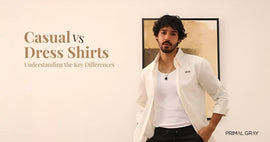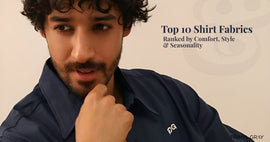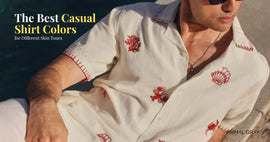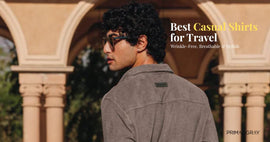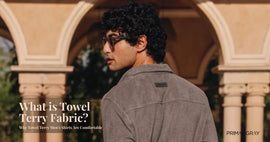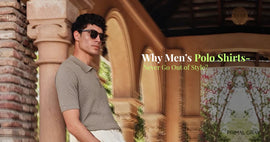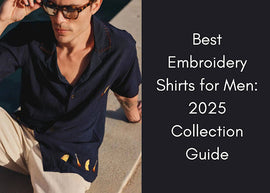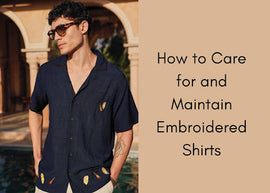Formal Shirt vs Casual Shirt: 6 Essential Differences Every Man Should Know
Posted by Primal Gray
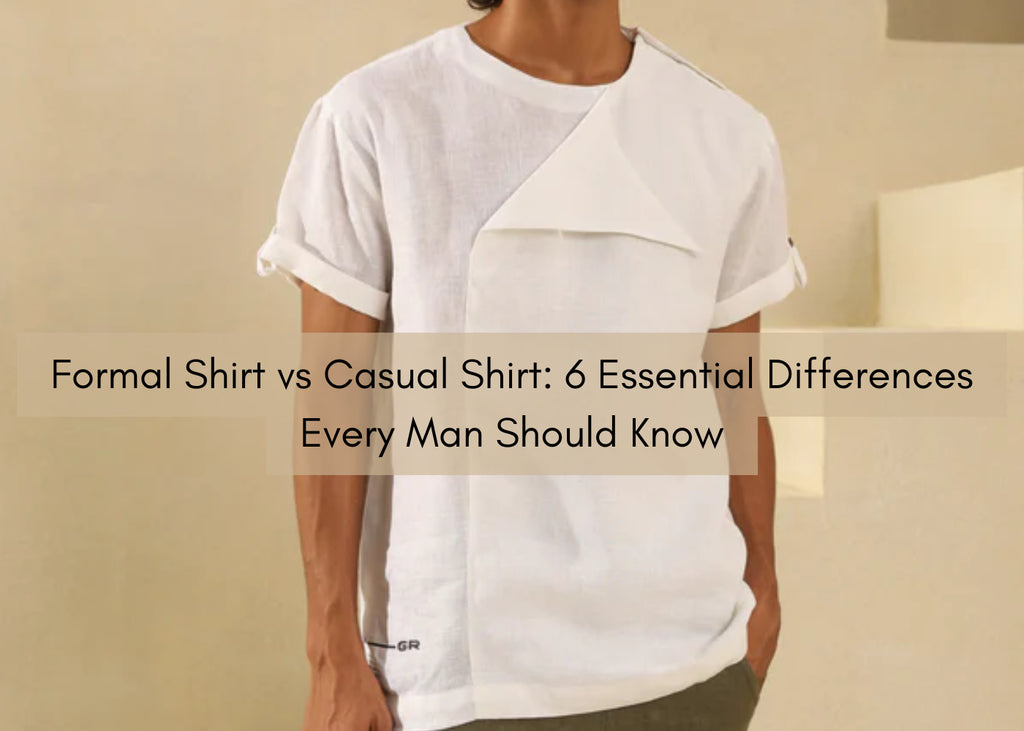
Every guy has faced this moment: You’re invited to an event and the dress code says “smart casual” or “business formal,” and suddenly, you’re staring blankly at your wardrobe. The difference between a formal shirt vs casual shirt may seem simple, until it isn’t.
Your shirt sets the tone. Wear the wrong one, and you’re either overdressed like a banker at brunch or underdressed like you crashed a wedding in flip-flops.
So let’s fix that. This men’s shirt guide walks you through six essential differences so you always know what to wear from office meetings to weekend parties.
What’s the Actual Difference Between Formal and Casual Shirts?
At the core, a formal shirt is designed for structure, polish, and professionalism. A casual shirt, meanwhile, is about relaxed fits, breathable fabrics, and expressing personality.
Quick example? You wouldn’t wear a tuxedo shirt to a beach barbecue. And you (hopefully) wouldn’t wear a printed rayon shirt to a job interview.
Now let’s break it down category by category.
Fit & Structure: Sleek vs Relaxed
Here’s how fit dictates function:
- Formal Shirts are Streamlined and Sharp: Designed to complement suits and blazers, these shirts follow your body’s contours. Think slim-fit or regular-fit, never sloppy. A proper fit means no ballooning at the sides and sleeves that hit right at the wrist. You’re not just wearing a shirt; you’re wearing intention.
- Casual Shirts are Comfort First: These are the chill guys in your closet. Roomier cuts, extra movement in the shoulders, and zero pressure to tuck. Whether you’re lounging or brunching, the relaxed fit works with, not against your body.
Style Pick: The Draped Lapel Shirt is perfect if you're after relaxed tailoring. It’s loose, airy, and made from GOTS-certified linen, built for high-functioning comfort.
Fabric Choice between Crisp and Breezy
The fabric makes the man or at least, it defines how he feels after eight hours in the same shirt.
Formal shirts typically use cotton poplin, broadcloth, or blended twill, engineered for structure and minimal wrinkling. These fabrics are smooth, sometimes stiff, and always ready to impress at client meetings.
In contrast, casual shirts embrace more breathable materials like linen, rayon, flannel, or organic cotton. They absorb moisture, feel light on the skin, and tend to drape naturally, ideal for humid days or layered looks.
Collar Types, Tie-Friendly vs Personality-Driven
Let’s talk about collars, the unsung heroes of shirt identity.
If you’re dressing for formality, you need a collar that stands up straight and plays well with ties. That means spread collars, cutaway collars, or the classic point collar, all designed to tuck neatly under a blazer.
But casual shirts? They’re a playground of style. You’ll find Cuban collars that shout “poolside cocktail,” band collars for the minimalist kings, and the iconic button-down collar, equally at home under a sweater or solo with jeans.
Go Asymmetric: The Patch Work Shirt turns collars into conversation starters. Its folded cuff and modern cut give it the presence of a formal shirt without the fuss.
Subtle vs Expressive Design and Pattern
When it comes to prints, formal shirts keep it quiet, casual shirts scream (in a fun way).
Formal Shirt Patterns:
- Solid white or pastel tones
- Subtle pinstripes
- Micro-checks or herringbone
- Occasionally muted polka dots or textures
Casual Shirt Patterns:
- Tropical florals and palm prints
- Patchwork and embroidery
- Bold stripes, graphic motifs
- Tie-dye, ikat, or color-blocking
Style with Art: The Beach Embroidered Shirt features light silk embroidery for a touch of “Cabana Bond” elegance, laidback luxury with zero effort.
Detail-Heavy vs Easygoing Sleeves & Cuffs
Sleeves aren’t just about covering your arms, they shape your entire vibe.
Formal shirts come with long sleeves and defined cuffs. Often, the cuffs are buttoned, and in premium pieces, they’re designed to hold cufflinks. It's the full business package.
Casual shirts, however, let you play. You get short-sleeved options, rolled-up sleeves, and even tab sleeves (the ones with a button to keep them folded). They’re all about movement and minimal structure.
Quick Suggestion: For something casual with a dressed-up twist, go with the Patch Work Shirt, the folded cuffs give it a low-key polished finish without feeling stiff.
Your Styling Intent Matters
Context is everything. A shirt isn’t just a piece of fabric, it is a signal.
- Boardroom Bound? You want structure and symmetry. A crisp formal shirt in solid white or light blue, neatly tucked, possibly with a blazer. No patterns, no nonsense.
- Cocktail Party Casual? Think a smart casual shirt in darker hues with interesting textures. Untucked is fine. Add loafers or clean sneakers.
- Beach Brunch or Resort Dinner? You’re calling in breezy materials and relaxed tailoring. Oversized casual shirts or something embroidered do the trick.
- Date Night at a Gallery? Go linen. Go open collar. Go something like the Draped Lapel Shirt, which balances sophistication with laid-back charm.
Formal Vs. Casual Shirt Showdown
Still can’t decide between boardroom polish or weekend ease? This quick-glance table breaks down the core differences between formal and casual shirts, so you can dress right without overthinking it.
|
Feature |
Formal Shirt |
Casual Shirt |
|
Fit |
Tailored or Slim |
Relaxed or Loose |
|
Fabric |
Cotton, blends |
Linen, rayon, denim, flannel |
|
Collars |
Point, Spread, Tab |
Cuban, Band, Button-Down |
|
Patterns |
Solid, pinstripes |
Bold prints, florals, embroidery |
|
Sleeves |
Long with cuffs (sometimes French) |
Rolled up or short sleeve |
|
Best for |
Office, Weddings, Interviews |
Parties, Travel, Casual Fridays |
Primal Gray Helps You Nail Your Shirt Choices
Primal Gray makes shirt shopping simple. Whether you need sharp tailoring for the office or breezy fits for the weekend, our collection covers both. No need to juggle brands or compromise on style. Just one wardrobe, two worlds and you are sorted.
Check out our premium shirt collection now. Use code FIRST10 for 10% off your first order.
Key Takeaways
- Formal shirts are crisp, structured, and made for business or ceremonial settings.
- Casual shirts lean on relaxed fits, fun patterns, and breezy materials.
- Collars and cuffs define the shirt’s role. Tie-friendly for formals, playful for casuals.
- Fabrics dictate formality. Stiff cotton vs breathable linen/rayon.
- Styling depends on the destination. Meeting vs meetup, pitch vs picnic.
- Fit is everything. You should feel confident, not confined.
Frequently Asked Questions
1. What’s the difference between a formal and casual shirt?
A formal shirt is designed for polished settings like offices, weddings, or interviews. It typically has a structured fit, stiff collars, and is made from smooth fabrics like cotton or blends. Casual shirts are more relaxed in both fit and function, often made with breathable fabrics like linen or rayon and featuring bolder prints or softer collars. Think sharp and serious vs. cool and comfortable.
2. Can you wear a casual shirt to work?
Yes, but it depends on your office dress code. For smart-casual or creative workspaces, a clean, neutral-toned casual shirt like a linen or cotton blend, paired with chinos can strike the right balance. Avoid overly bold prints unless your office vibe encourages personal flair. If it’s a formal environment, stick to traditional dress shirts.
3. What fabrics are used in formal shirts?
Formal shirts are typically made from cotton, cotton blends, poplin, or broadcloth. These fabrics hold structure well, resist wrinkles, and create a smooth, crisp silhouette under blazers or suits. Some premium variants even offer slight stretch for added comfort during long hours of wear. Always check GSM (grams per square meter) if you're comparing fabric weight.
4. Are formal shirts always plain?
Not necessarily. While solids like white, blue, or pastels are common, formal shirts can also feature subtle patterns such as pinstripes, checks, or textured weaves. However, the overall look remains restrained, meant to complement suits rather than compete with them. If a shirt’s pattern appears louder than your tie, it’s probably not formal.
5. How do you style a casual shirt for a night out?
Pair your casual shirt with dark denim or chinos, roll up the sleeves, and go for loafers or clean sneakers. Shirts with Cuban collars, embroidery, or relaxed fits work well here. You can also layer with a lightweight jacket or open the top buttons for a more effortless, confident vibe.
6. What’s the best shirt for office vs party?
For the office, opt for a tailored formal shirt in a neutral color like white, light blue, or gray, preferably tucked in with dress pants. For a party, switch to something with texture or print, like an embroidered or patchwork casual shirt. It’s about matching energy: go structured for work, expressive for play.

